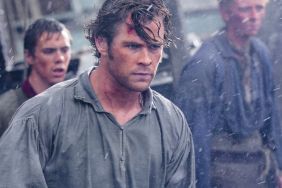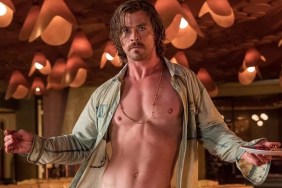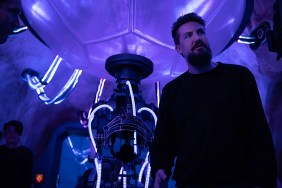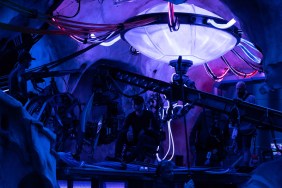It’s been two years since I got the opportunity to check out the London-based filming of Ron Howard’s new movie, but with its December 11th release fast approaching, it’s finally time to share the details from the In the Heart of the Sea set visit.
Based on Nathaniel Philbrick’s In the Heart of the Sea: The Tragedy of the Whaleship Essex, the movie tells the story of the men who went out to sea in August 1819 eager to fill their ship with oil and then head home to their loved ones in Nantucket as quickly as possible. When they come to the conclusion that the nearby whaling grounds are all fished out, they opt to take a risk and head to offshore grounds instead. Upon arriving, they think they’ve hit the jackpot, but when an enormous whale attacks and destroys their ship, the surviving crew must resort to troubling tactics in order to stay alive while stranded in the middle of the ocean.
After rolling through the gates of Warner Bros. Studios Leavesden and passing by a swarm of students eager to walk through the Harry Potter Exhibition, it was down a road littered with props and set dressing including small boats, oars, barrels and even whale bones. However, when we hopped off the bus, it didn’t feel like we were in a staging area or even at a movie studio for that matter. We were basically standing in Nantucket circa 1820.
Nantucket 1820
Even though the unit publicist insisted that In the Heart of the Sea was a low-budget production, there was nothing about the film’s Nantucket set that suggested that Howard and his team held back in any respect on this project. The portion of Nantucket constructed at Warner Bros. Studios Leavesden consisted of about a dozen different buildings including the Friends Meeting House, a two-story black structure dubbed the Nickerson Boarding House, and the Raymond Ropemaker and Caulker building.
However, the crowning jewel of the Nantucket set was undoubtedly the activity on the dock. Half of the set was constructed on dry land, as would be the case with any period piece town, but the other half was built on a tank. A dock extended from the Nantucket street, reached out into the murky water and at the very end of the structure, that’s where we found the Essex. But it actually wasn’t the Essex at that time. What was once the Essex had been turned into a different ship for that specific scene, the one that takes the surviving crew members back to Nantucket to reunite with their families at the end of the movie.
The Production Design
While waiting for Howard to start shooting, we got to spend some time with production designer Mark Tildesley. Here are some highlights from our conversation:
- As one might expect, Tildesley had to know a good deal about the whaling industry in Nantucket in order to create the sets. He explained that there were about 310 ships in Nantucket at the time and that they’d each go out for about four years and return with 1,000 barrels of spermaceti oil a piece.
- The whales were too big to bring on the boats, so the crew would have to “sushi them” first and then bring the pieces on board so that they could melt them down.
- Tildesley’s team initially tried to find a shooting location on the coast of England, but when that didn’t pan out, they decided to build a harbor themselves.
- They made the ship themselves as well. “It’s built in steel and then we clad it on the outside and then inside there are air tanks. Previous to having this set here, we were just out in the sea here.” He also noted that after they finish up shooting the Nantucket material, they planned to take the ship to the Canary Islands to get some full sail, wide shots of the structure.
- They opted out of using a gimbal to create the rocking effect and instead used the aforementioned air tanks. Tildesley broke it down; “There’s air tanks inside the ship. We fill them with water or air, that causes buoyancy, and then we rock them with hydraulic arms, which is a new technique. Normally people use gimbals, but we decided to use the natural science of the water itself.”

The Maritime Bank
During our chat, Tildesley also took us over to a Nantucket building he seemed especially proud to share, the town’s maritime bank. Inside, the space consisted of three sections – rows of communal desks in front of a giant blackboard used to record the value of whale oil, rows of tall, individual desks that were likely used to prep deposit slips, and then, of course, the gleaming gold teller windows where the whalers handed over their earnings for safekeeping. The three sections came together to create one big, beautiful room with an exceptional sense of warmth due to the combination of the gold gates with the glowing green lamps and the wood floors.
Producer Paula Weinstein
Back outside, clouds rolled in and a light drizzle picked up, so producer Paula Weinstein stepped in to chat about her long journey with the book. Here are some highlights from that conversation:
- Even though we’re with the crew of the Essex for most of the movie, the story is also being told from an old Thomas Nickerson’s (Brendan Gleeson) perspective as he recounts the details of the incident for “Moby-Dick” author Herman Melville (Ben Whishaw). Weinstein further explained, “The story between Melville and the old Nickerson is in itself a compelling story of a writer coming to find the theme that he wants for his own masterpiece, or what turned out to be his masterpiece, and Melville’s frustration at not being as successful as Hawthorne.” However, it is important to note that Melville did not meet Nickerson in real life. Weinstein told us that they took dramatic license with that plot point.
- Just like the source material, the big screen rendition will address the issue of classism and racism in the industry. The captain of the Essex, George Pollard (Benjamin Walker), is a member of one of the top whaling families of Nantucket. Weinstein explained, “They were not only racist, they were classist. The Quakers were a very closed society.” Pollard’s cousin, Owen Coffin (Frank Dillane), is a racist. Pollard himself is not, but he doesn’t do anything to stop it. Weinstein continued, “They belittle Chase, Chris Hemsworth’s character. They keep calling him a landsman because [of] his father.” Chase’s father was a farmer and even though Chase isn’t ashamed of that, that doesn’t change the fact that he still has to overcome that history if he wants to captain his own ship one day. Pollard actually has a similar issue. Weinstein added, “Pollard would make a great Barrister or lawyer, but not a whaling captain, but he has to do it because that is the family tradition. So they are two men locked in situations that neither of them is happy in.”
Filming Nantucket
Back on set, Howard and co. were getting closer and closer to shooting. Extras were meticulously placed, Hemsworth and Walker were present and accounted for, and there was a machine out in the water tank that simply lifted a square panel up and down to create a wake.
As the smaller boats rocked in the background, the main action commenced on the dock. With an angle looking down the dock in the direction of the boat, Howard captured a noticeably-thin Hemsworth in rather ratty clothing as he stumbled forward and embraced his wife. After bending down to meet (yes, meet) his child, he catches sight of a much more dapper looking Pollard donning a high-end black coat. Owen rises and shakes Pollard’s hand.
Before resetting for another take, Hemsworth went into the Harbor Master building on the dock and then came back out for a quick makeup touch-up. Not only is his skin still caked in dirt from his exploits, but Owen’s skin is also quite red as well, presumably from being under the sun for months with no cover.
During the actual take, Hemsworth repeated the same actions, but this time, it was captured by two cameras – one sitting stationary where the dock meets the road and the other on an especially active steadicam. Even when the scene got to the point when Owen and Pollard were stationary, having their exchange, the steadicam operator captured the moment by circling the conversation, a technique that seemed quite in line with what we heard about cinematographer Anthony Dod Mantle’s plan to shoot In the Heart of the Sea like a sports movie.

Benjamin Walker as Captain George Pollard
As a heavier rain moved in, Walker was given the chance to step off set to chat. Here are the highlights:
- Walker wasn’t thrilled about dropping a ton of weight for the film, but he would only jokingly complain about it. “The next five weeks are gonna be, what’s the word? Hell! I mean, it’s kind of lame to complain about considering there are actually people starving around the world. We just have to eat quinoa every once in a while. Also, these guys, the fact that they actually did it, it’s kind of the least we could do to tell their story.” Walker explained that they’re working out every day and estimated that, by the end of the film, they’ll be down to eating just 500 calories a day. “But again, uptown problems.”
- The more enjoyable part of the physical training for Walker was all the sailing skills he got the opportunity to learn. “That’s one of the joys of being an actor, is that you get to learn these new skills – knot-tying, we went to Cornwall and spent some time on an actual whale ship, spent some time rowing on the Thames building teamwork. We’ve had a nice time.” He also laughed and added, “I’m really glad I’m the captain, I’ll tell you that, because I just boss people around. I met a real captain in Cornwall and I said, ‘What’s your biggest challenge as captain?’ He said, ‘Well, sometimes I get a blister right here on my finger from holding my coffee mug,’ So this is the part for me!”
Chris Hemsworth as Owen Chase
When Hemsworth came over, he certainly didn’t look unhealthy, but having just seen him in Thor: The Dark World three nights before, it was abundantly clear that he gave up a significant amount of muscle mass for this role. Check out the highlights from our interview below:
- Naturally the first question was about his weight. Hemsworth explained, “I think I’m around kind of 185 and I was 215 for Thor. I’m not necessarily an unhealthy white male, it’s just that I was at such an extreme for Thor.”
- Apparently it’s much harder for him to lose weight than to gain it. “It’s the second time I’ve done it, both times with Ron, so maybe he’s got some obsession with me being skinny. I don’t know. [Laughs] But each time you put the muscle back on, your body has that muscle memory and wants to hang on to it, so you just have to be well underfed and over-trained to get it off and it’s exhausting.”
- The movie’s rendition of Chase and Pollard’s relationship differs a bit from the book, so Hemsworth broke it down for us; “In our version of it, we take creative license and there’s a lot of friction between the two of them from the get-go and Nickerson is sort of the observer, but also obviously interacting quite heavily once things take off.” He continued, “Ben’s fantastic. I think we both had the same idea about having these guys be in conflict, but underneath, there’s an amount of respect and that’s always an interesting rivalry. It’s the same with the Nicky Lauda, James Hunt story that me and Ron talk about often.” He concluded, “One of the most successful things or one of the most exciting things about that relationship was the fact that you don’t have that kind of competitiveness towards someone unless there’s an amount of respect to it.”
Ron Howard
Next, Howard came our way but before jumping into the conversation, he made a point to tap an extra on the shoulder and compliment his work in a previous day’s scene. (Now that’s got to make someone’s day.) Here are the highlights from our discussion…
- First Howard spoke to the overall look of the film. “Our general approach to this, Anthony Dod Mantle and I, he’s the same cinematographer who did Rush, so this is our second time working together, is to try to capture this world in a very authentic way and photograph it in a very psychological, emotional and contemporary way. We want the authenticity to be there, but we don’t want to approach it as a classic. We want to approach it as though a modern group was somehow transported back and able to get this story on film. So it leads to [being] a little more experimental visually, bolder, lot of risks.”
- Apparently this shooting technique will be quite the challenge for his editors. “Dan Hanley and Mike Hill, we’ve been working together for years and they thought ‘Rush’ was their biggest challenge to date which they did a brilliant job on, but now they are, pardon the pun, drowning. Drowning in footage.”
- Howard also finds shooting digital to be liberating. “This is actually only my second film to shoot digitally. We’ve been editing digitally for 15 years. To me, it’s liberating. I’m getting closer to what I had in my mind quicker. And I also find that experimentation is a little less daunting a decision to allow. I think it sort of facilitates people taking even more risks, and that’s something that I’m really enjoying.”

Aboard the Boat
While the crew set up to get the reversal, we got the chance to board what was once the Essex. In real life, the “tall boat” playing the Essex and Chase’s rescue boat is known as the Phoenix. In addition to the immense assortment of ropes and sails, the Phoenix was also outfitted especially for Dod Mantle’s camerawork so that he could shoot the scenes from multiple angles.
When everything was up and running again, we watched from the boat as the steadicam followed Hemsworth from behind as he made his way down the dock to is family. After that, we hit the next stop on our tour, the sound stage.
Owen Chase’s House
The plan was to shoot a scene inside Chase’s house the next day, so that set was on the stage and ready for filming. The house consisted of a single room that was broken up into sections. We walk in near the “bedroom,” which was basically the corner of the house with a bed in it. There was also a dining room table with a rowboat hanging right above it. Diagonal from that we found the kitchen which was nothing more than some cupboards and a surface for pots and pans.
The Water Unit
After enduring a good deal of rain and icy temperatures, it was a thrill to walk into what was basically a sauna. Glasses and phone screens fogged up as we made our way over to the entrance of the pool in which visual effects supervisor Jody Johnson was busy working on an underwater sequence. On the monitors we could see a close-up of an actor submerged in the water, which is meant to be part of the opening sequence of the film involving some Spanish sailors. The moment clearly occurs during an attack because during our interview with Johnson, he was pulled aside to figure out whether or not that actor needed his blue arm sleeve so that they could make it look as though it’s been torn off in post. Here are some other highlights from our chat with Johnson …
- Johnson is aiming to keep the whale “on the right side of real.” He further explained, “We’ve been working on his design, his character, trying to understand what his motivations are and that will help drive our performance. He’s primarily a CG whale and we’re shooting the reactions of all the actors and all the bits and pieces to go with our CG whale.” He continued, “All his behaviors and his movements and his instincts are all driven by what happens in nature, so we’ve done a lot of research. We’ve been working with a couple universities to really understand how whales move and how they act and why they act like that, and that allows us to build reality into our dynamic stunt sequences.” Johnson also threw in, “We don’t want him to be a monster. He’s a creature, you know? He’s a real animal and we need to keep him that way.”
- The whale has a name, and it’s an especially fitting one. Johnson revealed, “We call him Moby.”
Tom Holland as Young Thomas Nickerson
Before wrapping up for the day, we got the opportunity to chat with the actor portraying the youngest crew member on the Essex, Tom Holland. Here are the highlights …
- Nickerson gets the worst chores of anyone aboard the Essex. Holland noted, “Because I’m the cabin boy, I get all the worst jobs aboard a ship. I would have to clean the deck, I would have to do loads of other stuff that cabin boys do. And it does mean that a lot of the time I am covered in whale oil or I’m wet through or I’ve got barely any clothes on because all my older mates have stolen them and all that kind of stuff. So a lot of the time Nickerson is very uncomfortable, which has been quite tough, but we’ve got a great team of guys who are all looking after us.”
- We won’t get to see much of what life was like for Nickerson prior to the disaster, but Holland shared a few details about him. “There wasn’t really much to his life. He’s been an orphan all his life. He has, in real life, three older sisters, which he didn’t know. We’re not really playing that in the film. He just went to school, slept in the streets, slept in rooms that he could get to and he just didn’t really have that much of an exciting life. Why I think [this[ character is so special is that he goes from this kind of ordinary, boring Nantucket life to this incredible adventure with these 100-foot creatures and Mr. Chase who is just a monster of a man. So it is an amazing switch, but we don’t get to see his life previous.”
- Clearly Holland can’t share any scenes with Gleeson, but the two Nickersons did do a little prep work together. “We did one or two sessions to kind of create a similarity in our accents, and Ron sent me some videos of him and Brendan working together so that I could try to pick up some of his characteristics and all that kind of stuff. So I spent about a week and a half trying to become a young Brendan Gleeson, which was good fun actually.”
- Holland also detailed young Nickerson’s relationship with Chase. “Chase is like the perfect man. He’s incredibly macho, he has an amazing authority over everyone and he’s also incredibly skilled, so he’s someone that Thomas really, really looks up to and he soon becomes [a] father figure towards Tom, because he doesn’t have a dad.” He added, “A really lovely moment in the film is three nights into the voyage I start to feel really seasick and start to go green, and Chase throws me over the edge of the boat and dangles me there for 20 seconds to try and make me throw up, which sounds awful but when he comes up, he says, ‘Oh, now you’ve got something to write to your mother about,’ and we have this whole conversation about how both of us are orphans. So then there’s the first sort of connection in our bond.”
- There was a lot of Thor fans on set, including Holland himself. He began, “[Thor: The Dark World] came out like three or four days ago and I’ve watched it and I’ve just been bugging him with questions so much. [Laughs] And he’s cool! He’s answering it!” Holland also added, “It’s funny, today we’ve got like 300 extras on and in our starting positions in the scene we’ve got like 12 kids, and they’re all like 7 or 8 and, poor Chris, today it was all, ‘Mister Chris, Mister Chris, how heavy is your hammer,’ and all that kind of stuff. [Laughs]”
Wrapping Up
You don’t step onto a set like In the Heart of the Sea and not walk away wowed by the scale and detail of the effort, but what could really wind up making the adaptation a standout is the source material. Nathaniel Philbrick’s book isn’t a particularly smooth read because he departs from the primary narrative to offer a significant amount of historical context, but the story of the Essex is prime for a big screen adaptation. There will undoubtedly be loads of high seas action, but what could turn the film into a truly unforgettable experience is getting the chance to dig into the everyday challenges of working in the whaling industry and then the pressure of having to resort to such extreme tactics to survive when nearly all is lost.
In the Heart of the Sea
-
In the Heart of the Sea

-
In the Heart of the Sea

-
In the Heart of the Sea

-
In the Heart of the Sea

-
In the Heart of the Sea

-
In the Heart of the Sea

-
In the Heart of the Sea

-
In the Heart of the Sea

-
In the Heart of the Sea

-
In the Heart of the Sea

-
In the Heart of the Sea

-
In the Heart of the Sea

-
In the Heart of the Sea

-
In the Heart of the Sea

-
In the Heart of the Sea

-
In the Heart of the Sea

-
In the Heart of the Sea

-
In the Heart of the Sea

-
In the Heart of the Sea

-
In the Heart of the Sea

-
In the Heart of the Sea

-
In the Heart of the Sea

-
In the Heart of the Sea

-
In the Heart of the Sea

-
In the Heart of the Sea

-
In the Heart of the Sea

-
In the Heart of the Sea

-
In the Heart of the Sea

-
In the Heart of the Sea

-
In the Heart of the Sea

-
In the Heart of the Sea

-
In the Heart of the Sea

-
In the Heart of the Sea

-
In the Heart of the Sea

-
In the Heart of the Sea

-
In the Heart of the Sea

-
In the Heart of the Sea

-
In the Heart of the Sea

-
In the Heart of the Sea

-
In the Heart of the Sea

-
In the Heart of the Sea

-
In the Heart of the Sea

-
In the Heart of the Sea

-
In the Heart of the Sea

-
In the Heart of the Sea

-
In the Heart of the Sea

-
In the Heart of the Sea










